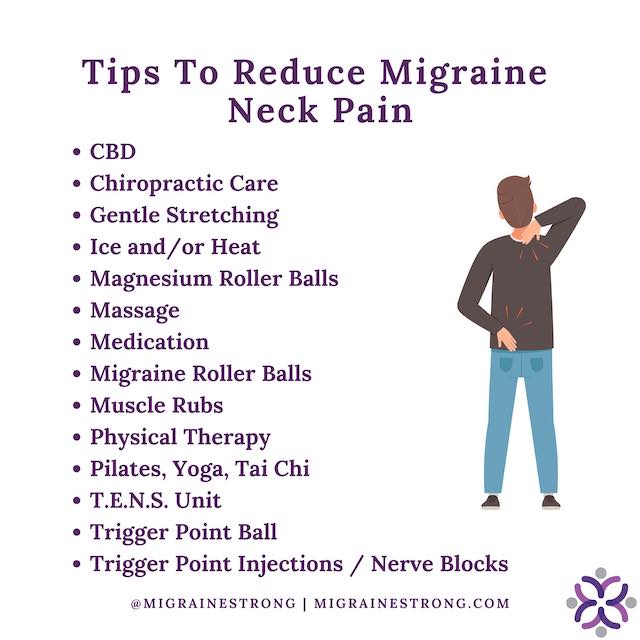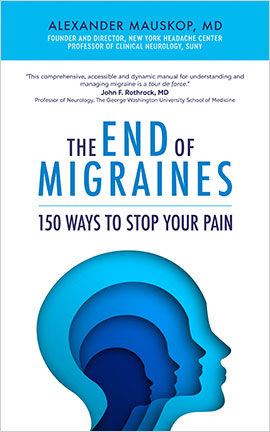A stiff, painful neck is common when it comes to migraine. I have had neck pain along with migraine for as long as I can remember. It took me a long time to realize, and believe, that the stiff, painful neck was actually a symptom related to migraine. It was not a separate underlying condition for me. However, cervical neck dysfunction can co-occur with migraine which can make the diagnosis more difficult.
My diagnosis of neck pain due to migraine was certainly complicated by the fact that I had herniated a disc at the C6-C7 area of my spine shortly after my son was born. Because of this, I really thought that the years of neck pain before and after this injury were all related, even though physical therapy was successful in treating my ruptured disc.
Why was I still so convinced that the pain in my neck was a separate underlying condition? Simply because it wasn’t until my headache specialist explained the connection between migraine and a stiff, painful neck that I became aware of the symptomology.
**While Migraine Strong writes about the latest in migraine treatments, this is not medical advice. We are patient educators and all information you read should be discussed with your doctor.
Neck pain with migraine
More than half of all migraine patients report neck pain during their migraine attacks. A recent study showed that patients who experienced neck pain during their migraine attacks, also had increased pain and tenderness between attacks. (1) Another study refers to the trigemino-cervical complex (the pathway between the trigeminal nerve which activates during migraine and the cervical area of the spine, in the neck) and how this provides a link for referred pain. (2)
Essentially migraine activates in our brains, and we often feel the pain in our neck first. This makes it seem as if the neck pain triggered the migraine attack. In reality, the neck pain is often the first warning sign that a migraine attack is imminent.
I can most definitely relate to this from my own experience. Without question, my first physical pain symptom of migraine is a painful, stiff neck and it can trigger anxiety about the oncoming attack. Migraine and anxiety are common partners and it’s worth learning how to feel less anxious.
Neck pain and eye pain
My migraine stiff neck pain starts at the very top of my spine, where the base of my skull meets my neck. It is almost a burning sensation at first. Gradually, I feel it connect to my eye. Even though I’m feeling it a bit right now, I find it hard to explain. There’s a knot on the right side of my neck and I know that when the migraine attack is completely gone, it will be gone as well. When I had chronic and intractable migraine, the knot was always there and so was the neck pain. It wasn’t until I got better control over my migraine that I was able to reduce my overall neck pain.
Neck pain – where it comes from and proper diagnosis
Upper neck pain, with or without headache, is called craniovertebral (or craniocervical) junction abnormalities (CVJ). The CVJ is the place where the brain transitions into the spine. The CVJ is made up of the occipital bone (back of the head) and the first two cervical vertebrae’s called the Atlas (C1) and Axis (C2). There are also complex vascular and nerve structures in this area. (3)
Pain in this area could result from the cervical vertebrae’s not being formed properly, being fused together or possibly being out of alignment. You could be born with any of these issues or they could be a result from a neck injury. To determine if the CVJ is part of the reason you are feeling pain, a doctor might order a CT (computed tomography) scan or a MRI (magnetic resonance imaging) test. Depending on what is found, physical therapy might be recommended to try to alleviate your pain before other more invasive options, like surgery, are considered.
If you have intense, persistent neck pain, discuss the type and location with your doctor to see if further testing is in order. Pain radiating to your arm or tingling in the hand should be discussed with your doctor.
Upper cervical adjustments
The most common question we hear when we talk about a misaligned spine is about chiropractic care. The National Upper Cervical Chiropractic Association (NUCCA) has a focus ‘on the biomechanics of the upper cervical spine (neck) and its influence on the central nervous system and brain stem function.’ They believe that ‘appropriate management of this relationship can help restore body balance supporting optimal spinal health.’ (4)
In a small case study linked on the NUCCA website, 11 neurologist diagnosed migraine patients, with atlas misalignment and no previous upper cervical chiropractic care, were followed to see if they improved and sustained their results after upper cervical adjustment. All patients were imaged to determine Atlas misalignment to help develop the chiropractic manual adjustment strategy. The ‘results suggest that the atlas realignment intervention may be associated with a reduction in migraine frequency and marked improvement in quality of life yielding significant reduction in headache-related disability’. (5)
Functional Neurologists
Functional neurologists are also asked about during discussions on neck pain and migraine. While many think this term refers to a neurologist, the specialty is actually within the chiropractic field. This article explains just what the specialty is and the requirements for training. (6) If you have upper cervical neck pain, it’s a good idea to consult with your doctor first. Our article on chiropractic care and migraine headaches, an interview with a chiropractor, might help you determine the right course of action.
Spinal cord compression symptoms
Compression of the spinal cord comes with symptoms that should be investigated. These nerve related problems can cause quality of life issues, especially affecting functionality. Contact your doctor if you have any of these symptoms:
- Weakness in your arms and/or legs
- A loss of awareness of your limbs (this is called position sense)
- A feeling of electric-like pain or tingling shooting down your spine and into your legs after bending your neck forward (this is called Lhermitte sign)
- Reduced sensations of heat and cold in your hands and/or feet
- Reduced pain sensation (7)
The pain that I felt when I had the herniated disc in my neck was pain under my shoulder blade. It was excruciating and I was sure it was a problem with my shoulder. I never dreamed that I had a significant problem with my neck based on the pain in my shoulder.
Sometimes steroids will be prescribed for for acute relief. Since prednisone for migraine (as well as other steroids) can be quite helpful, you might find the short course of therapy helpful for both head and neck.
Sinus headache – neck pain, things to know
A recent study looked at neck pain in those that had self reported sinus headache (SRSH). They found that ‘neck pain and cervical musculoskeletal dysfunction are common among persons with SRSH and may be a comorbid feature or contributing factor to headaches attributed to rhinosinusitis.’ (8) I found this to be interesting as another study found that 90% of self reported sinus headache is actually migraine.
Of people with chronic migraine or chronic tension type headache, 60-80% identify stiff neck pain as one of their symptoms. In the neck pain study, 84% reported headache with their neck pain. These results indicate that ‘the neck pain might be part of the headache symptom complex rather than reflect a local cervical cause’. (8)
Cervicogenic headache
‘The term cervicogenic headache is commonly misused and does not simply apply to a headache associated with neck pain; many headache disorders, including migraine and tension-type headache, can have associated neck pain/tension.’ (9) Cervicogenic headache is a secondary headache disorder which means it is caused by another condition. These conditions include rheumatoid arthritis of the upper cervical spine, tumors, fractures or possibly an infection.
‘Misdiagnosis of cervicogenic headache, potentially leading to delays in appropriate migraine management, have caused frustration among neurologists.’ (10) Make sure that you are evaluated by a knowledgeable specialist to determine if you have cervicogenic headache and not migraine or tension-type headache.
How migraine neck pain affected me
I had daily attacks while overcoming my 18 years of chronic and intractable migraine and neck pain was constant as well. I tried many things to alleviate my neck pain, but what finally relieved the pain was defeating the chronic cycle. This was the first time I truly believed my neck pain was linked to migraine. When I finally had a break in migraine pain, the neck pain disappeared and I realized my headache specialist was right about it being linked to migraine. My new goal was to figure out how to stretch those good days into even more migraine attack free days. If you haven’t read about how we approach treating migraine, check out our blog about the Treatment Pie.
Even when I was having daily attacks, I could always feel my neck pain ramp up before my migraine head pain would spike. I felt like I had to protect my neck from wind and cold. Sometimes, if the weather was dicey, I would avoid going to my son’s baseball games or my daughter’s golf matches. If I did go, I would dress in a way that would shield my neck from the gusting wind. If it was at all windy outside, I would avoid walking the dog or golfing on those days. The wind could trigger my neck pain on a relatively low pain day and send me to bed.
Now that we know about painful migraine stiff neck – what’s next?
It’s one thing to know and understand that neck pain is likely part of migraine. The next obvious question is what can we do about it? What can we do to help minimize the symptoms?
We all know that having fewer migraine attacks is our ultimate goal. We have pulled together our best tips for how to treat neck pain while you are in the thick of migraine. The following lists are things you can talk to your doctor about or try at home to minimize the pain in the neck that migraine has become.
Talk To You Doctor About:
- Trigger Point Injections – Trigger points are smalls knots that can form in your muscles. If present in your neck, your doctor might suggest a round of these injections that consist of steroid and anesthetic.
- Nerve Blocks – These might be an option depending on the severity of your neck pain and your overall migraine condition. Discuss this option with your doctor.
- Physical Therapy – Ordered by your doctor, the physical therapist can teach you special exercises to help relax, stretch and strengthen your neck muscles.
- Chiropractic – Finding a practitioner who is knowledgeable with migraine is key. Many chiropractors can also advise about making changes to posture especially in the workplace.
- Massage – A knowledgable massage therapist can be helpful with neck pain as well. I was never helped much by having my trigger points released, but I know others that were. Drinking lots of water before and after massage is also key.
- T.E.N.S. Unit – This is a Transcutaneous Electrical Nerve Stimulation Unit. There are a couple of theories for how these actually work to relieve pain. This is an option that can be used in conjunction with physical therapy.
- NSAIDs or Steroids – Your doctor may recommend a short course of NSAIDs or steroids to help relieve your pain. Our article can help if you are wondering about how to get rid of rebound headaches.
Migraine neck pain treatment you can try at home
- Pure Enrichment Neck & Shoulder Heating Pad – A good heating pad can be a life saver when it comes to neck pain. This one is plush and doesn’t pill. It can wrap around your head and is wonderfully comfortable.
- Huggaroo Neck and Shoulder Wrap – This is a microwavable heating pad with herbal aromatherapy. It offers a deep moist heat that is great for both neck and shoulder pain. An unscented version is also available.
- Peace Love Rally – This roll on magnesium feels awesome for neck pain. They immediately soothe sore, painful muscles providing much needed relief. Both of my kids use them too. (Get 10% off with code MIGRAINESTRONG)
- Forces of Nature – The neck pain roller ball is really helpful during an attack. I love that the roller is small and can easily be packed in a migraine relief kit or purse. (Get 20% off with code NATUREMS19)
- Primal Botanicals – Head & Neck CBD Rub – This is a wonderfully soothing balm that I love to apply to my neck when I am having migraine symptoms. It is made by a Registered Nurse and clinical herbalist who is also a member of our Migraine Strong Facebook group. (Get 10% of with code STRONG10)
- Green Goo – This is natural skin care for inflammation, joint pain, sore muscles etc. I can be very sensitive to smells and this one has a super light scent with background notes of ginger and peppermint. It is very soothing.
- Trigger point balls – This ball will grip a surface and allow you to massage trigger points in your neck.
- Tennis balls – Take two tennis balls (some people use lacrosse balls) and put them in the end of a sock and tie it off tightly. Lie on your back on the floor and place the tennis balls at the base of your skull. Allow your head to rock back and forth and side to side for just a few minutes. Simple and inexpensive.
- Pilates/Yoga/Tai Chi – If you are a sloucher, practicing one of these disciplines can help you to improve your posture. They are also great forms of exercise and movement.
- Icy Hot – I love this stuff and it is so easy to pick up at your local store. Roll it on your neck and it lasts for hours.

Where To Go From Here
I hope you have some new insight into the migraine stiff neck pain you have been experiencing with your migraine attacks. While these tips help with daily symptoms, lasting relief can be found with better overall control of migraine symptoms. Was finding this control easy for me? Considering it took me 18 years to find what worked, I would say no. But figuring out how to reduce my overall disability from migraine by using the Treatment Pie significantly changed my life.
We talk about how to use the Treatment Pie in our blogs and in our private Facebook group. If you are searching for a way to potentially reduce your overall migraine attacks, come check us out. We’d love to hear about your experiences with stiff neck pain and migraine. Drop us a comment here, on Facebook or Instagram.
References:
- https://pubmed.ncbi.nlm.nih.gov/31852232/
- https://www.frontiersin.org/articles/10.3389/fneur.2019.00276/full
- https://www.spineuniverse.com/conditions/upper-neck-disorders/upper-cervical-spine-disorders-anatomy-head-upper-neck
- https://nucca.org/
- https://ucmonograph.org/wp-content/uploads/2016/02/Effect-of-Atlas-Vertebrae-Realignment-in-Subjects-with-Migraine.pdf
- https://www.ncbi.nlm.nih.gov/pmc/articles/PMC6413643/
- https://www.spineuniverse.com/conditions/upper-neck-disorders/signs-symptoms-upper-cervical-disorders
- https://www.ncbi.nlm.nih.gov/pmc/articles/PMC7025697/
- https://americanmigrainefoundation.org/resource-library/cervicogenic-headache/
- https://www.neurologyadvisor.com/topics/migraine-and-headache/neck-pain-linked-to-migraine-may-not-indicate-cervical-musculoskeletal-dysfunction/
Image by Andreas Göllner from Pixabay



This article is very timely for me. I just went to a consultation at an upper cervical chiropractor who took xrays of my neck and found a 4% misalignment in my atlas (c1). Which he says was significant and likely contributing to my constant neck pain and migraines. The treatment plan he is suggesting is incredibly expensive. I’m confused if this could be an actual cause of my pain or if I’m being persuaded as all chiros tend to do…
I have so many problems related to vestibular migraines with food triggers, migraine pain, cervogenic headaches, cervical vertigo and have seen upper cervical chiropractos years ago for other problems such as nystagmus episodes, vertigo episodes,, and sound induced nystagmus.
No one, including this article has talked to me about l-glutamine supplementation rational and how it can all be related to both tight muscles causing the above problems and a leaky gut causing vestibular migraines. I have already been taking l-glutamine for maybe 3 months now after a short term mega dose protocol and even got off my nortruptyline that dampened my problems. I am a long time sufferer and am feeling almost normal again, I need more time for my muscles to stretch to further relieve the nerve pinching. Reach out to me if you want to hear more about this. It’s hard for me to fathom why this isn’t talked about and tried more. I’m 29 now first migraine episodes were AIWS at age 9. Please someone on this site do some research and or talk to me, I would love to get the message out there.
This is an outstanding article. I am a migraine sufferer for the past 52 years, and experiencing the same symptoms which you are describing in your article. I am studying your article in more detail and congratulate you in the way you compile the content. Thank you. Walter Vercueil, Centurion, South Africa.
This is very helpful info. I too thought that neck area pain is one of my migraine severity increase triggers, so learning that it’s actually an early (and continuous) symptom is very useful.
Thank you all for your science based work and communication!